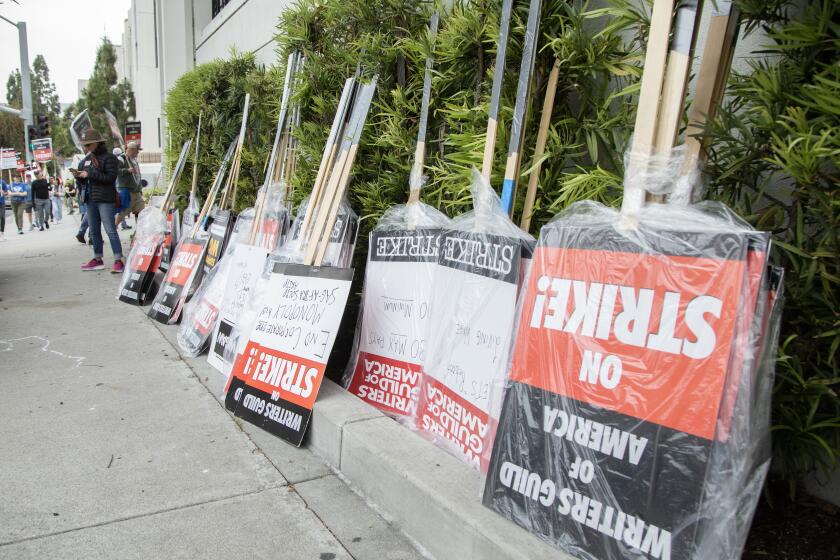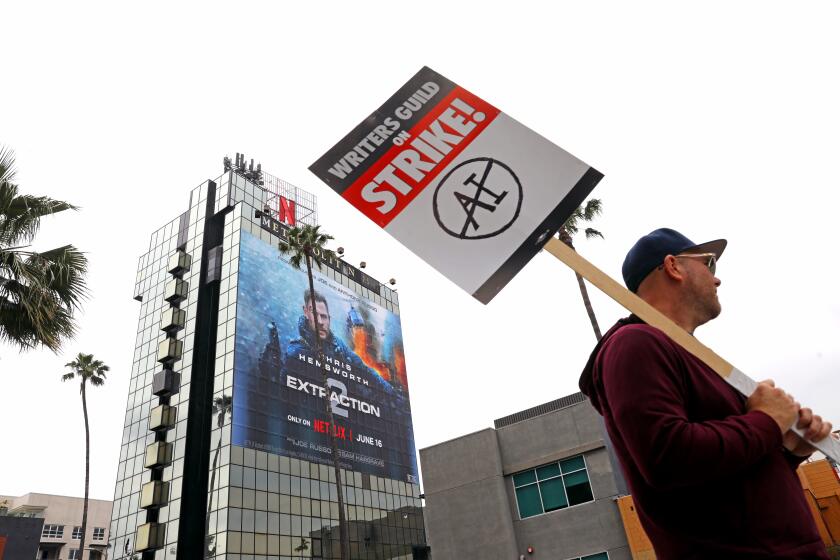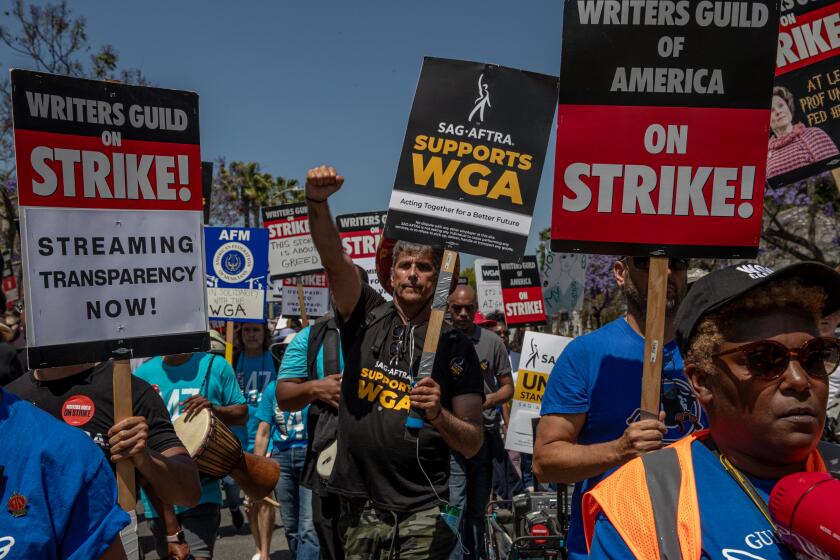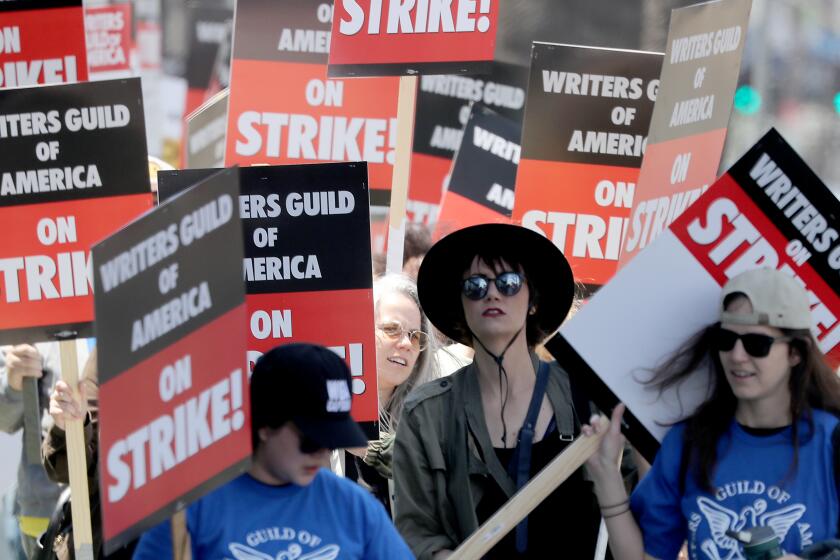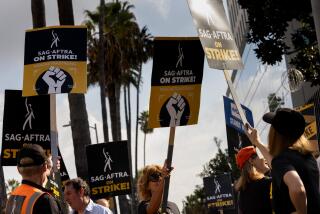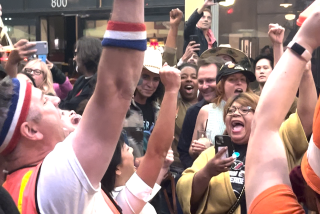False starts, secret talks: Insiders tell how the writers’ strike ended with ‘Let’s make a deal’
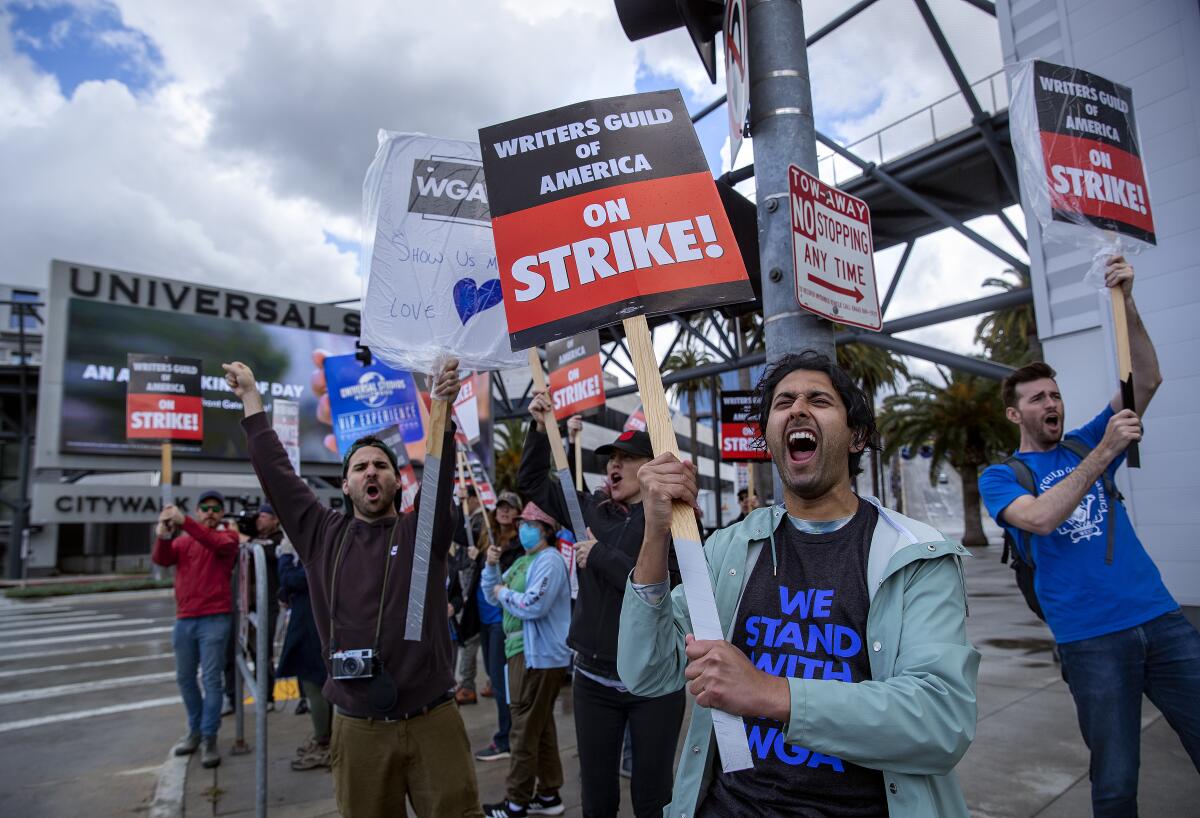
As the bitter, months-long strike by the Writers Guild of America against the major media companies spilled into September, neither side could agree on whose turn it was to make the next proposal.
Negotiations were tied in knots for weeks. Then, finally, the breakthrough came.
Chris Keyser, the WGA Negotiating Committee’s co-chairman, called Walt Disney Co. Chief Executive Bob Iger on a Sunday night, Sept. 10. Speaking for more than an hour, the two agreed it was silly to squabble over turns. They needed to work together to resolve the stalemate, and Iger promised to spend as long as it would take to get a deal done, according to people close to the process who were not authorized to speak publicly.
Negotiators representing the Writers Guild of America and major studios reached a tentative agreement for a new labor contract, ending a writers’ strike that began in early May.
Three nights later, Keyser reached out to Warner Bros. Discovery CEO David Zaslav, who was attending a dinner in New York’s Hudson Yards to celebrate news anchor Christiane Amanpour’s 40th anniversary at CNN. Zaslav stepped away from the party to take Keyser’s call.
One week later, Iger, Zaslav and two other industry titans — NBCUniversal Studio Group Chairman Donna Langley and Netflix co-CEO Ted Sarandos — arrived early at the Alliance of Motion Picture and Television Producers’ headquarters at the Sherman Oaks Galleria to begin marathon bargaining with WGA negotiators, which culminated Sunday night in a deal.
On Wednesday, the strike ended after 148 days, making it one of the industry’s longest.
As Hollywood tries to get back to work, the big question remains: Why did it take so long to end the writers’ strike? In an industry founded on creative collaboration, how did the two sides end up so deeply distrustful of one another that the business was brought to a grinding halt, causing billions of dollars in economic pain not only in Hollywood but for the Los Angeles economy as a whole?

“It shouldn’t have taken this long,” said entertainment lawyer Robert Schwartz, who was not involved in the deal. “The strategy for the studios going in was: ‘Let’s wait them out.’ But that didn’t work, at least not to the extent that the studios wanted, and they finally said, ‘OK, fine, let’s make a deal.’”
In the end, a perfect storm of trends — deep anxieties over new technology, a nationwide surge in pro-labor activism, the messaging power of social media and historic solidarity among entertainment industry workers — collided with tactical miscalculations by studio chiefs to bring Hollywood to its knees.
Negotiators representing the Writers Guild of America and major studios reached a tentative agreement for a new labor contract, ending a writers’ strike that began in early May.
The contrasts with the last writers’ strike in 2007-08, which lasted 100 days, quickly became apparent. Fifteen years ago, solidarity between the industry’s unions — and among writers themselves — had quickly frayed as the economic toll of the labor action began to mount. Talk show hosts, including Jay Leno and Conan O’Brien, restarted their programs. Prominent showrunners openly challenged the WGA leadership.
Not this time.
“It took the AMPTP, and eventually the CEOs, 102 days to even understand that the game they had played in 2007 was not going to happen this time,” Keyser said this week in an interview.
Instead, members of SAG-AFTRA, representing 160,000 performers, joined the writers on strike in mid-July.
“There were many conversations between us and CEOs [during the last six weeks],” Keyser said. “But it took until the CEOs walked into that room and came to terms with the problems that we have been talking about for five months that a deal actually happened.”

Neither the AMPTP nor its member companies commented on the tentative deal.
With the new three-year agreement, the WGA gained much of what it had demanded back in April, including higher pay, minimum staffing requirements in writers’ rooms, bonuses for successful streaming shows and protections against the threat of screenwriters being replaced by artificial intelligence. The studios agreed to guarantee second-step payments to film screenwriters so they don’t have to spend months and months doing rewrites without a check.
In one particularly contentious issue, the companies agreed to share with the guild the number of hours a show is streamed, domestically and internationally, under a confidentiality agreement.
Key takeaways from the tentative contract that would end the writers’ strike, and how it addresses writers room staffing, streaming residuals and artificial intelligence.
Said WGA West President Meredith Stiehm: “We won.”
When the writers walked off the job on May 2, years of mounting frustration over the industry’s shift toward a streaming-centered business model suddenly exploded into public view.
Though the advent of streaming had ushered in a boom in demand for content — a record 599 scripted original series ran on linear channels and streaming services last year — writers found themselves working longer hours for less money. The median weekly pay for writer-producers has declined by 23% over the last decade, according to the WGA’s figures.
For the Writers Guild, which had flexed its muscle in a successful battle against the major talent agencies in 2019 over the practice of charging fees for packaging shows, a strike seemed the best, if not the only, way to hold the line against further erosion of writers’ livelihoods.
“We fought in their streaming wars and now we want our fair share,” WGA board member Dante Harper said earlier this month, while walking the picket line outside Television City in Los Angeles’ Fairfax district. “People allowed conditions to get like this in the frenzy of the streaming wars, but those cows are now coming home.”
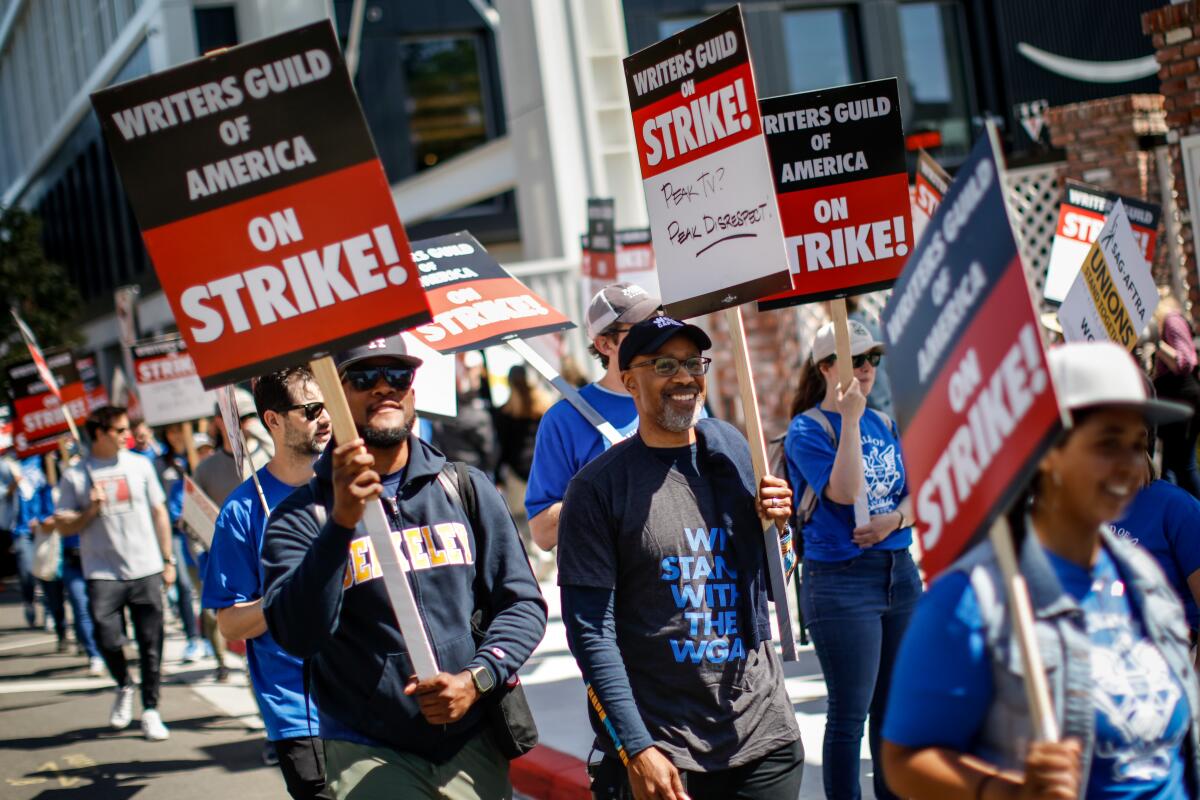
Major studios such as Walt Disney Co., Warner Bros. Discovery and Netflix resisted writers’ demands last spring, insisting that they faced their own pressures to cut costs in the face of ballooning debt levels, concerns of a possible looming recession and uncertainty about the future of the streaming business. Media companies have cut nearly 20,000 jobs in the last 18 months — about a third of those at Disney.
With both sides claiming the stakes were existential, the stage was set for what everyone feared could be a protracted and economically devastating strike. And it was.
Cal State Northridge associate professor of entertainment media management Todd Holmes estimates that the dual strikes have cost California’s economy about $5 billion.
In the early weeks of the strike, the battle played out as much on social media as it did on the picket lines, with writers portraying executives as callous, overpaid fat cats unconcerned about the workers they profited from. On picket lines, writers hoisted signs bearing easy-to-grasp messages such as “The CEOs Have Yachts, Writers Have Mortgages” and “We Just Want 2% From the 1%.”
Through a network of strike captains, the guild also moved aggressively to shut down productions that continued filming, such as Showtime’s drama “The Chi” in Chicago.
The WGA drew growing public support as what came to be known as “hot labor summer” began to heat up. That support was vividly on display in late May when Zaslav was met with a chorus of boos from students when he received an honorary degree and delivered the commencement address at Boston University.
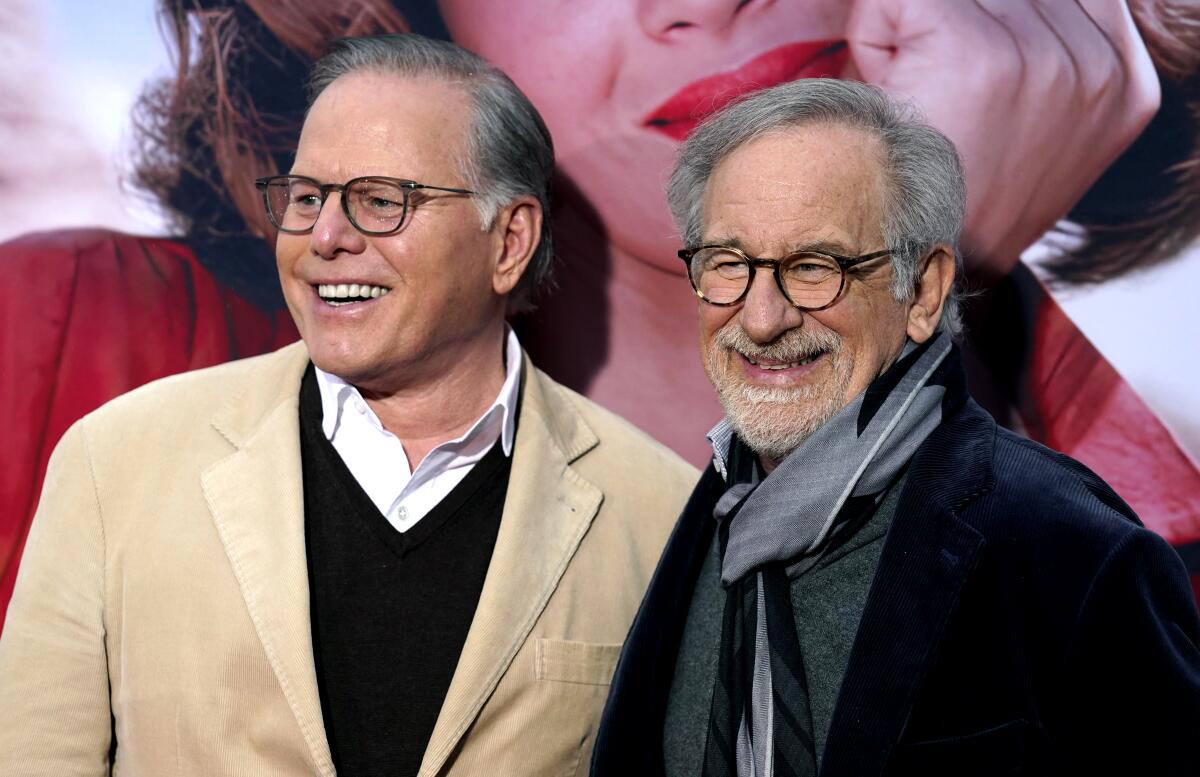
The announcement in early June that the Directors Guild of America had reached a deal over a new contract with the studio alliance did little to tamp down the anger among writers.
Indeed, the atmosphere turned even more combative in July when Deadline published an article quoting anonymous executives saying studios were willing to let the strike grind on for several more months in an effort to bring the writers to their knees. “The endgame is to allow things to drag on until union members start losing their apartments and losing their houses,” one unnamed executive told the publication.
An AMPTP spokesperson said the anonymous person was “not speaking on behalf” of the alliance or its members.
“The most amazing thing about that quote was that somebody said it out loud,” Brian T. Arnold, a WGA strike captain at Paramount Pictures, said this week. “It laid out the way the AMPTP feels about artists and feels about their writers. It was clear that they wanted to bleed us out, they wanted us to be desperate enough to take a bad deal.”
Days after the Deadline article was published, the writers got thousands of new allies on picket lines. On July 13, SAG-AFTRA announced its own strike against the AMPTP, ratcheting up tensions in an industry that had not seen a joint strike by actors and writers since 1960.
Hollywood is once again in the midst of a historic labor battle in which studios are facing a possible strike on two fronts in a protracted fight over new forms of distribution.
As writers and actors amplified their battle on social media, the studios drew growing criticism for appearing uncaring and out-of-touch.
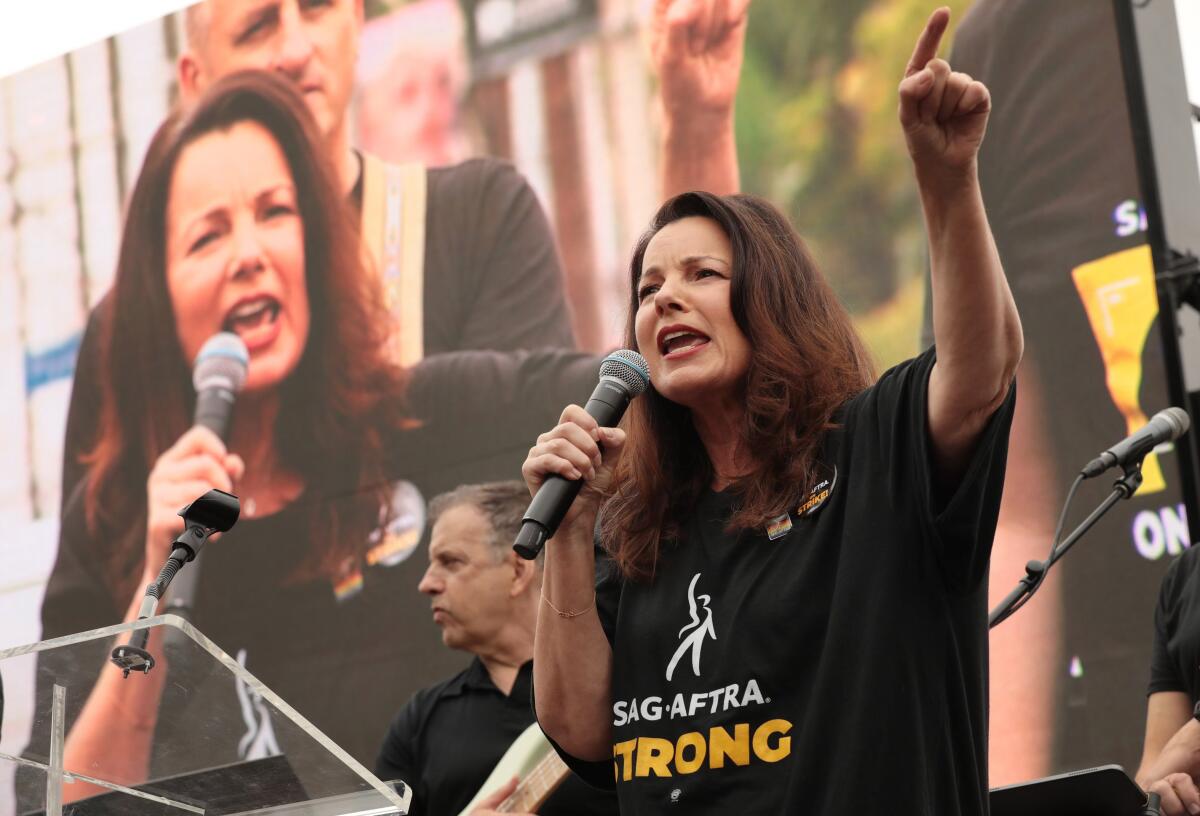
In an interview with CNBC on the day the actors’ strike began, Disney’s Iger called strikers’ demands ill-timed and “not realistic.”
To many, Iger’s argument was undermined by the fact that he was speaking from Allen & Co.’s Sun Valley Conference in Idaho, informally known as “summer camp for billionaires.” Mountain meadowlarks chirped in the background.
Hours later, at a news conference announcing the strike, SAG-AFTRA President Fran Drescher delivered a fiery and instantly viral speech that galvanized actors and writers, shaking her fist as she blasted what she regarded as the greed of the studios and streamers.
“I am shocked by the way the people that we have been in business with are treating us,” Drescher said. “It is disgusting. Shame on them.”
The presence of SAG-AFTRA members on picket lines reenergized the writers’ cause.
And as the summer wore on, despite the mounting damage to the local economy, there was little outward sign of a fracturing in the resolve.
While the Los Angeles City Council unanimously passed a resolution supporting the writers and several members popped up on the picket lines, Mayor Karen Bass studiously avoided entering the fray. There was speculation during the summer that the coalition-building politician might attempt to broker peace in Hollywood, but such a mediator role did not come to pass.
Bass remained in contact with executives and WGA members throughout the summer. The frequency of her calls to key players increased during the last week of negotiations, according to someone with knowledge of the situation.
The box-office boost of the buzzy “Barbenheimer” phenomenon — the same-day releases of mega-hits “Barbie” and “Oppenheimer” — gave Hollywood a momentary jolt of optimism. Finally, it appeared the industry was recovering from the pandemic. Some wondered, wouldn’t the companies want to make a deal to get the dream machine humming again?
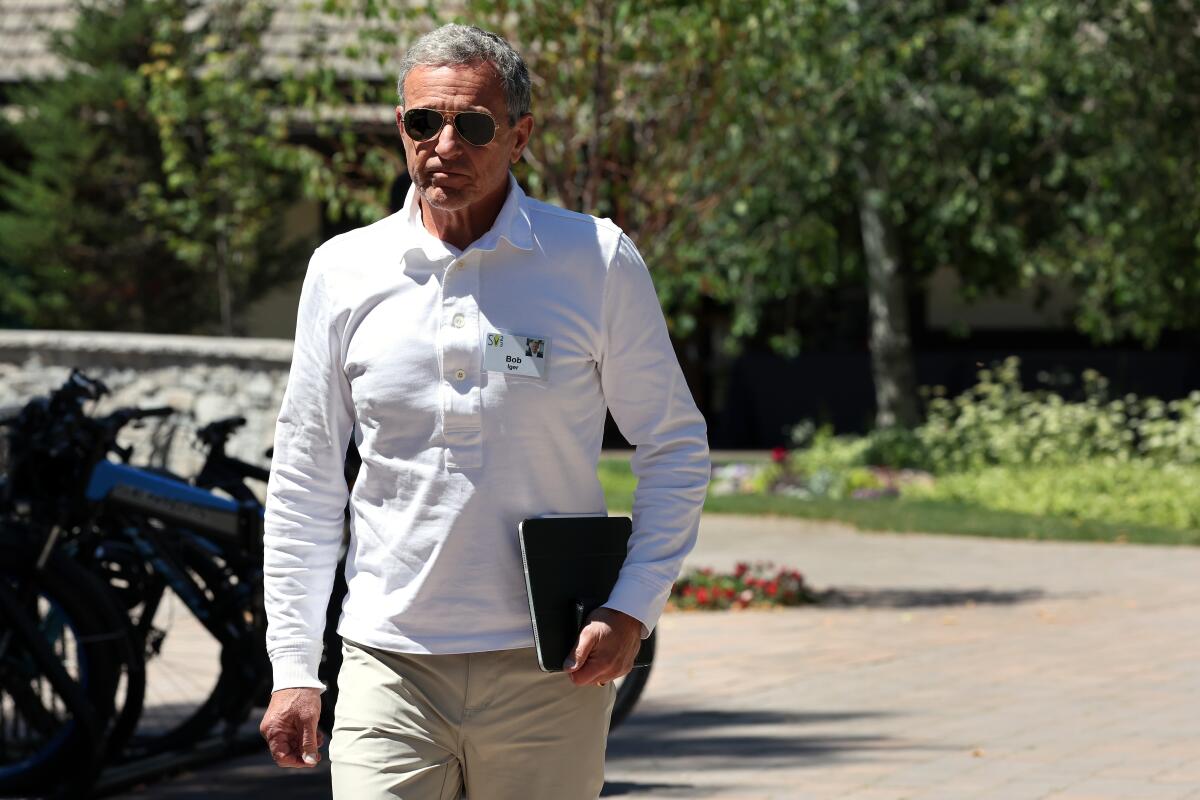
The strike did provide a short-term financial benefit for the companies. Paramount Global, Disney, Amazon Studios and others saved hundreds of millions of dollars that otherwise would have been spent making and marketing shows. For some of the traditional companies, the savings boosted their stretched balance sheets, which they use to impress Wall Street, in an otherwise challenging year.
But as the summer wore on, the actors’ walkout was hurting traditional film studios. Marketing movies without the promotional presence of their all-important stars proved a daunting challenge, hampering the releases of films including Paramount’s “Teenage Mutant Ninja Turtles” and Sony’s “Gran Turismo.”
Studios shifted to 2024 highly anticipated films like Warner Bros.’ “Dune: Part Two,” MGM’s “Challengers” and Sony’s “Ghostbusters: Afterlife” sequel and delayed production on a number of tentpole projects. A longer strike, they feared, would devastate the movie business, which hasn’t fully recovered from the COVID-19 pandemic.
Complicating matters was the more diverse makeup of the alliance, which now included tech giants Amazon, Apple and Netflix, which had long resisted the idea of sharing streaming data — a chief concern for writers.
By midsummer, Sony Pictures Entertainment CEO Tony Vinciquerra stepped up to restart talks.
AMPTP President Carol Lombardini — who has helped negotiate the studio’s labor contracts for 40 years — wasn’t certain writers were in a mood to compromise yet, according to people familiar with the situation who were not authorized to discuss it. Still, Lombardini didn’t stand in the way, and Vinciquerra invited some WGA negotiators to his home in Manhattan Beach.
The 2023 writers’ strike is over after the Writers Guild of America and the Alliance of Motion Picture and Television Producers reached a deal.
On July 26, Vinciquerra and two other top executives, Langley from Universal and Mike Hopkins, senior vice president of Amazon Prime Video and Amazon MGM Studios, sought to initiate a thaw in relations.
“It was an attempt to start a conversation on their part, and show that they were feeling pain,” said David Goodman, WGA Negotiating Committee co-chairman said. “But that wasn’t the beginning of the serious negotiations.”
On Aug. 11, the AMPTP gave a detailed 69-page counter-offer to the WGA, the first substantial proposal since before the May 2 walkout.
Writers and actors continued to picket in the sweltering heat. More than 3,000 union members showed up for a boisterous solidarity rally on Aug. 22 outside Disney’s headquarters in Burbank. Actors including Kerry Washington (“Scandal”) and Ron Perlman (“Sons of Anarchy,” “Hellboy”) took swipes at the big media companies.
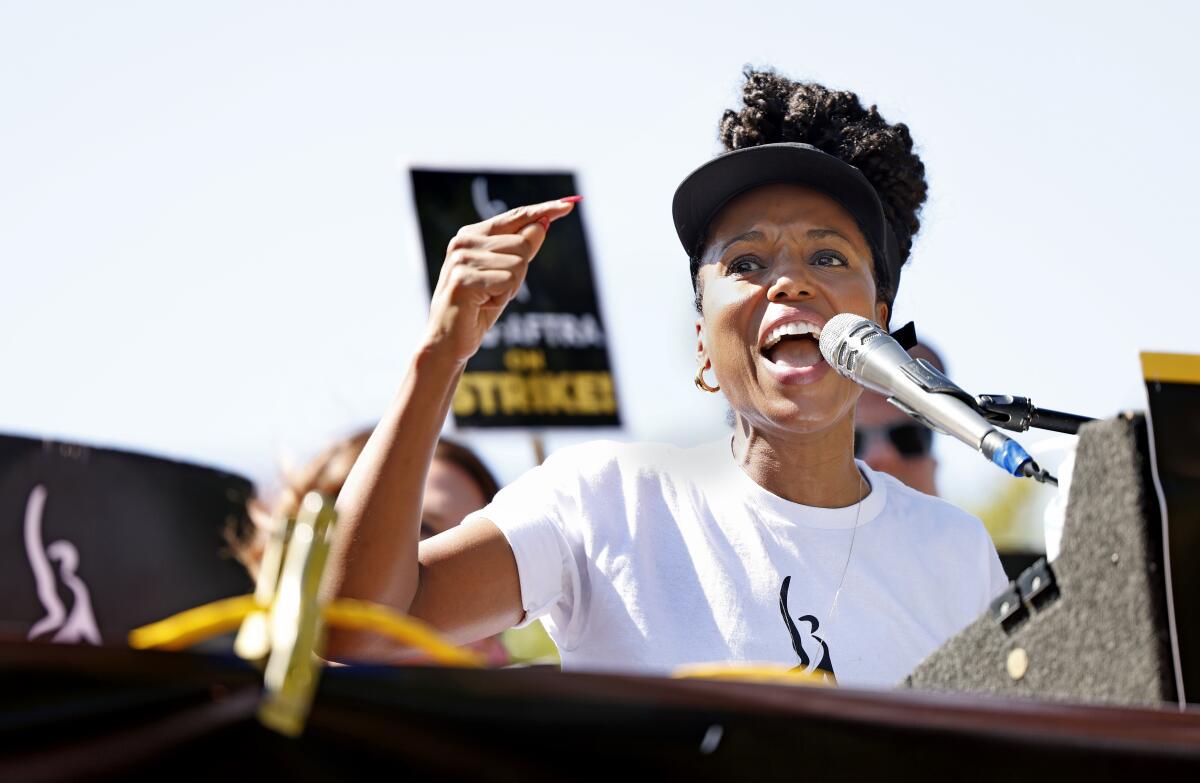
Top WGA guild negotiators skipped the rally. They were preparing for a meeting that night with media CEOs in hopes that the studios would get serious about the negotiations. But the writers left angry, saying they’d been subjected to a “lecture” about the strength of the studios’ offer. The studios only wanted them to “cave,” they said in a message to members.
Underscoring the lack of trust between the two sides, the studios immediately released a summary of their offer publicly.
The CEOs believed the public release helped put pressure on WGA leadership. Thousands of other Hollywood workers — camera operators, set dressers, carpenters, editors and Teamsters — had been out of work since spring.
But writers were incensed that studios were attempting to go around the WGA negotiators and dug in. WGA leaders denied that they’d received outside pressure from other labor groups or high-level showrunners to accept the studios’ terms.
“The only pressure we felt was from our members who were out on the picket lines, and they wanted us to get the right deal,” Goodman said.
Earlier this month, the strength of the WGA’s position was reinforced when Drew Barrymore said she would restart her syndicated TV talk show, sparking an immediate uproar. After days of blistering criticism, Barrymore apologized and walked back the decision. Bill Maher, who had announced his show would return without writers, also reversed course.
The backlash showed that, even as writers struggled with lost earnings and missed rent payments, their resolve was undimmed.
“Look, it’s really hard and stressful, but we absolutely have to put a foot down here,” screenwriter Ed Solomon, whose credits include “Bill & Ted’s Excellent Adventure” and “Men in Black,” told The Times earlier this month. “The longer the strike goes on, what I’m sensing is firmer resolve and more anger. We aren’t only striking for ourselves — we’re striking for the writers who come after us.”
Once serious negotiations restarted last week, the industry was rife with anticipation that a resolution could finally be in sight. Business news network CNBC reported the deal could be stitched up on Thursday. That was not the case, but the report unleashed wild rumors across Hollywood.
By Friday, the two sides were indeed nearing a deal — but it seemed to fall apart late in the day. Studio sources said the writers, after conferring among themselves, came back to press a few small issues.
The studios pushed back. “Guys, we’re on the 5-yard line, don’t come back here and say it’s a new kickoff,” said Zaslav, according to a person in the room.
Talks resumed Saturday and ended for the day at about 5 p.m., when AMPTP told the WGA that it had presented “the last and final offer.”
That night, Iger went to La Dolce Vita in Beverly Hills for dinner. A writer, one of nearly 500 participants in a WhatsApp thread throughout the strike, took a picture of the Disney chief. Fellow writers began guessing who Iger might be waiting for. In came Paul McCartney.
A photo of Iger and the Beatles legend was sent to the group. Someone suggested they send over a bottle of “Writers’ Tears” whiskey — but they didn’t.
The final meeting started Sunday, around 1:30 p.m. Just before dusk settled over Los Angeles and Yom Kippur began, the two sides announced the deal.
“There’s always an attempt to [say] things get driven by powerful people when it’s in their interest,” Keyser said. “But the real narrative of this strike is that 11,000 WGA members, most of whom you’ve never heard of, and 160,000 members of SAG-AFTRA, many of whom you’ve never heard of, had the power together to bring change.”
Now, as the studio chiefs turn their attention to ending the actors’ strike, it remains to be seen how easily or quickly the battered and embittered business can get back on its feet.
Staff writers Wendy Lee, Yvonne Villarreal and Julia Wick contributed to this report.
More to Read
Inside the business of entertainment
The Wide Shot brings you news, analysis and insights on everything from streaming wars to production — and what it all means for the future.
You may occasionally receive promotional content from the Los Angeles Times.
